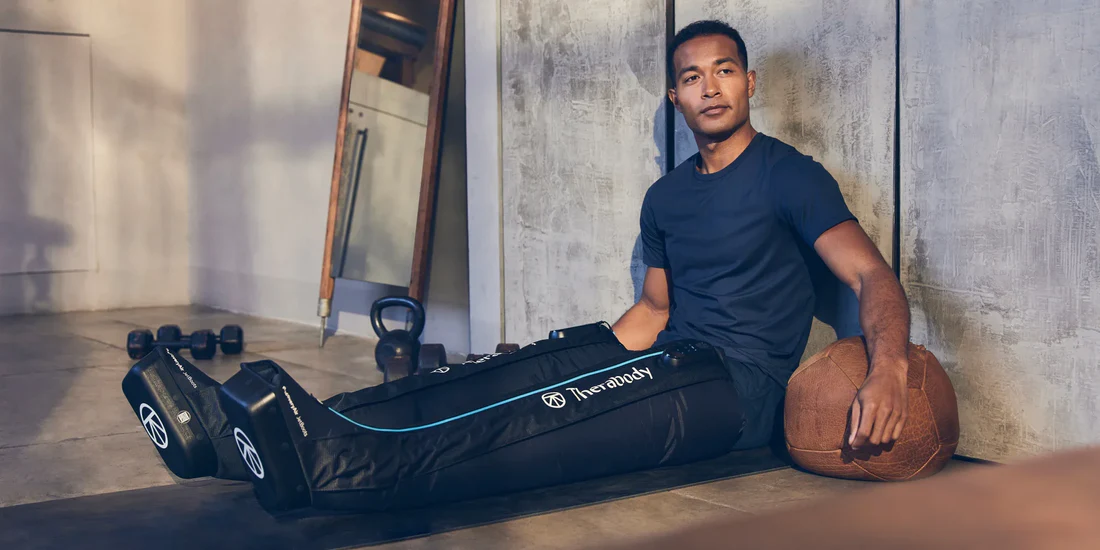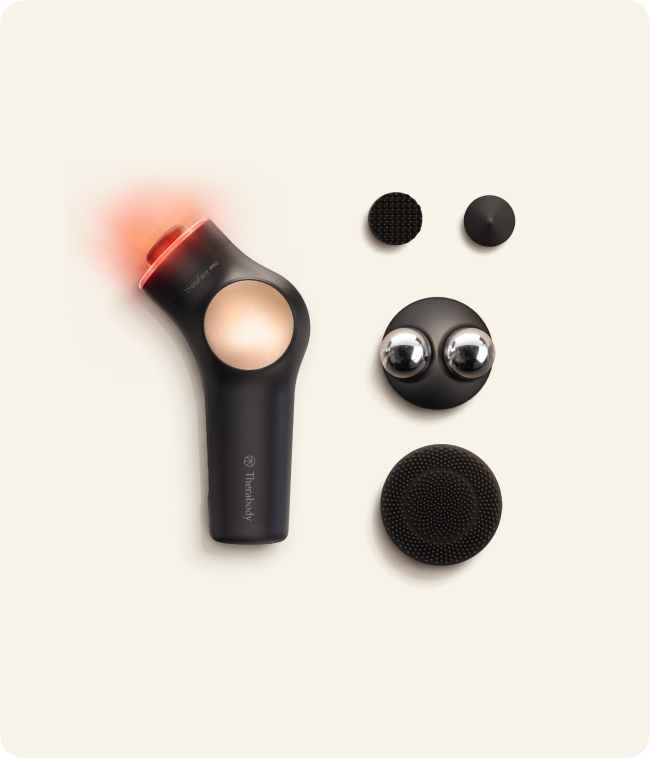
The Science Behind Pneumatic Compression Therapy Work: How Does It Work?
Authors: Therabody Scientists: Tim Roberts, MSc; Kyle Silvey, PhD; Michelle Darian, MS, MPH, RD, LDN
Spending too much time on your feet is tiring. Whether it’s for your job (looking at you healthcare workers, teachers, and those in the service industry), you’re training for a marathon or hitting a group fitness class a handful of times a week, or you’re chasing down your kids; you’re looking for some relief so you can be your best self the next day. Muscle soreness, fatigue, and stiffness are all things that can limit your progress. And allocating time for a proper recovery is often a limiting factor when you’re constantly on the go.
A seemingly new tool to help daily and exercise recovery that’s gaining popularity and at-home accessibility, especially among athletic individuals, is pneumatic compression devices, specifically boots. These inflatable sleeves — that resemble puffy knee-high socks — slide over the foot, ankle, calf, and even up to the thigh to deliver targeted compressive pulses to stimulate blood flow. But, this therapy has actually been used for decades in hospital settings. And now, more and more research is showing how beneficial pneumatic compression therapy is for circulatory and muscle health.
Let’s dive into the technical workings of these devices, the research-backed benefits, who can benefit from them (hint: it’s more than just athletes), and how to best use these devices at home.
What is Pneumatic Compression?[1]
Pneumatic compression is (most simply) compressive therapy generated by a device. Whereas compression socks, sleeves, or bandages deliver continuous compression where you wear them, pneumatic compression devices generate compression from a pump that precisely controls the amount of pressure and the intervals at which that pressure is delivered to the treatment area. [1] Intermittent sequential pneumatic compression (often referred to as ISPC) means that there is a sequential rhythm of timing to the pressure.
This mechanical inflation and deflation mimics the body’s natural muscle pump action — or the physiological action that promotes blood flow and circulation back to the heart. [2] Intermittent sequential pneumatic compression is a specific therapeutic form that has been used as a clinical treatment.
These pneumatic compression systems have been around since the 1950s, mainly to control swelling and then help prevent blood clots from forming in the legs of hospitalized patients. In the 1990s and early 2000s, the athletic community started to gain interest in using these tools for recovery benefits. [3]
The first pneumatic compression devices weren’t programmable (aka, they had only one setting) and delivered uniform compression throughout the covered area. The technology has evolved significantly since then in that devices have specific, targeted programming tailored to treat certain ailments (more on treatment benefits later). There are even separate air chambers[2] in the garment so that different parts of the body can receive different compressive settings or sequential treatment in the same session. [3]
How Does Pneumatic Compression Work?[3] [4]
First, let’s go over the nuts and bolts of how pneumatic compression devices work.
These systems involve an air pump and inflatable garments (like sleeves, gloves, boots, cuffs, etc.) to be worn on your body. When activated, compressed air from the pump is delivered into the garment — inflating it and creating pressure or a slight squeezing sensation (similar to a blood pressure cuff). [4]
And remember, pressure is delivered at a specific cadence in intermittent pneumatic compression therapy. So, the garments will inflate with pressure and then deflate and relax sequentially.
Now, this external pressure triggers an internal response from the body that promotes blood flow. That’s because the body is able to convert the mechanical energy from the pump into electrochemical energy that powers blood circulation to help move blood through the veins toward the heart. This is an essential step for moving waste products (and carbon dioxide) away from tissues. [2]
As blood vessels in the extremities (like the arms and legs) are small and far from the heart, they are often the most impacted if circulation is impaired for any reason — meaning waste products can build-up. This build up of waste products can make limbs feel stiff and sore. So, in summary, pneumatic compression helps keep blood flowing and those waste products from building up. [5]
Pneumatic compression and the lymphatic system
The lymphatic system is sometimes called the second circulatory system. It’s part of the immune system and helps the body transport immune cells, recycle important nutrients, and get rid of waste products. [6]
But unlike the circulatory system that’s powered by the heart, the lymphatic system doesn’t have a dedicated pump to keep things flowing. Instead, lymphatic vessels rely on muscle contraction to move the lymph (or fluid containing immune cells).
Pneumatic compression actually helps create the compression needed to increase the filtering of waste products[5] [6] (from the blood) into the lymph and the subsequent pumping of the lymphatic system to get rid of these waste products. [7]
The mechanics of pneumatic compression
A few important notes about the pressure settings of pneumatic compression devices to keep in mind:
- Intermittent pneumatic compression should deliver the most pressure furthest from the heart and less pressure in areas closer to the heart (the different chambers of the garment help deliver the correct pressure settings).
- This creates a gradient so blood and lymph flow in the right direction.
- The pressure should be tightly controlled in each chamber to ensure blood and lymph flow in the right direction.
- Devices should also be set to the optimal cycle of compression. The cycle is responsible for the increase in blood circulation. So the more cycles you complete in a setting with a pneumatic compression device, the more benefits you get.
Benefits of Pneumatic Compression Therapy
Pneumatic compression therapy’s main benefit is improving both blood and lymphatic circulation. Doing this promotes the delivery of blood, oxygen, and nutrients to the muscles and helps the clearance of waste from the blood.[7] [2, 7][8] [9]
This is the foundational physiological action that is linked to the slew of benefits below.
- Decreases soreness & speeds recovery: Strenuous exercise or strain from standing for long periods results in the increased formation of waste products in the blood. The buildup of that waste contributes to muscle soreness and fatigue. So, pneumatic compression can help clear or even prevent waste products from accumulating in the extremities and speed recovery processes. Less soreness means that you should be able to amp up training volume with a lower likelihood of discomfort or injury or feel refreshed and ready to stand all day again the next day. And for the person experiencing soreness from everyday activities, it can get you back to doing your work and daily activities faster. [8, 9, 10]
- Decreases swelling: Swelling occurs when there’s a buildup of fluid or inflammation, and feet are particularly prone to swelling. This can occur if you’re standing or sitting for too long. Exercise can also lead to swelling — which isn’t always a bad thing. Exercise places stress on muscles, causing small amounts of damage. The body mounts an inflammatory response to help the muscle heal and grow stronger. Intermittent pneumatic compression is effective in temporarily decreasing the swelling. [11]
- Decreases muscle stiffness: Muscle stiffness refers to a tight (even painful) feeling in your muscles. This could be from using muscles a lot (like in exercise) or from periods of inactivity (like from an injury or hospitalization). Pneumatic compression may help relieve this stiffness. [12]
- Improves range of motion: Loose, flexible muscles mean you can move or stretch your muscles further. An improved range of motion supports both athletic performance among athletes and general healthy aging. [13]
- Deep vein thrombosis prevention: Deep vein thrombosis (DVT) occurs when a blood clot forms in one of the veins hidden deep in the legs. Being sedentary or bedbound (say during extended hospital stays) increases the likelihood of DVT. Pneumatic compression can be powerful at keeping blood circulating in those who can’t move and help prevent these blood clots from forming. DVT prevention was actually why pneumatic compression was created in the first place. [14, 15]
- Cardiovascular benefits (post-exercise): The use of pneumatic compression post-exercise also seems to aid in cardiovascular recovery. In one study, pneumatic compression after high-intensity exercise helped to reduce strain on the heart. [16]
- Soft tissue and bone healing: For an aging population that is more likely to experience injuries and falls, supporting the health of soft tissues and bone is important in resuming everyday activities. And research shows that pneumatic compression can help with this healing process. [17, 18]
- Reduces pain: Pneumatic compression can help reduce pain for people who stand for extended periods, even more than just rest. Researchers of a study published in 2021 found that 20 healthy people (who stand a lot for work) experienced less pain and leg swelling when pneumatic compression was added to their routine over general rest. [9]
Who Can Benefit From Using Pneumatic Compression
Competitive athletes and those who want to truly optimize their fitness can benefit from adding pneumatic compression to their routine. These devices can be used to help you warm up by priming the muscles in a passive, low-energy expenditure way. They can also be used post-exercise to flush out waste and fluid from the legs before it has a chance to build up — leading to feelings of soreness and stiffness. [8]
People who are on their feet all day can also benefit from this therapy. This includes teachers, healthcare professionals like nurses and surgeons, firefighters, and delivery drivers (just to name a few). Standing for long periods is known to cause swelling in the feet, so pneumatic compression can help stimulate some much-needed blood circulation.
Pneumatic compression can also help people with general concerns of aging. Vascular blood flow appears to decrease with age (especially blood flow during exercise). [19, 20] So, pneumatic compression of older adults — of any activity level — may be beneficial.
Lastly, pneumatic compression may help with certain injuries or medical conditions. In these cases, it’s best to speak with a healthcare provider about the best use for your individual needs.
When to Use Pneumatic Compression Therapy
Pneumatic compression can really be used any time of day. You can also use pneumatic compression after a long day or if you want to show your muscles a little extra support.
For those who are using it in conjunction with a fitness routine, it’s best to complete this therapy before or after a workout for optimal results.
Before a workout, consider using the device for 15 to 20 minutes at a light pressure setting (typically around 20-35 mmHg). If you’re using this therapy post-workout or on a rest day, use it for around 30 to 45 minutes at a medium (40-65 mmHg) or intense pressure (70-100 mmHg) setting. Devices can also be app-connected or offer different protocols on the device for your unique needs.
If you’re looking for relief from a long day of standing, you can use these machines when you can finally rest — whether in the morning after a night shift or in the evening. Emerging research shows that pneumatic compression before bed may be beneficial for those with restless leg syndrome. [21] As always, it’s important to speak with a healthcare provider to determine if pneumatic compression is right for you.
How to Safely Use Pneumatic Compression Therapy Devices
Any at-home pneumatic compression device will come with its own use and safety instructions. Make sure you read those thoroughly before your first session.
However, best practices for using these devices typically include avoiding:
- Too much or too little pressure (the general “acceptable range" of pressure is roughly 20-100mmHg)
- Putting on an already-inflated boot or garment
- Standing in the boots
- Having any objects in your pockets
To safely care for your device, you should always unplug the air pump before cleaning it. Premium products in the market will have an internal construction, meaning there are no seams where sweat and bacteria build-up. All you have to do is unzip the device and gently wipe it down with a slightly damp, warm cloth or a 70% alcohol cleaning solution. Once you have fully cleaned the device, fully pat dry the surface and hang it to dry completely before continuing use.
The device shouldn’t take up too much storage space, and be sure to keep it out of direct sunlight.
Key Takeaways
- Pneumatic compression devices are a type of compression therapy that utilizes an air pump to deliver targeted compression to a cuffed area (via a boot or garment) to help blood circulation.
- Improving blood circulation to the extremities is especially beneficial for physically active individuals, those who stand regularly as part of their job, and those looking to support their circulatory system as they age.
- The benefits of pneumatic compression include decreasing soreness, expediting recovery, decreasing swelling, aiding muscle stiffness, improving range of motion, preventing DVT, helping bone healing, and reducing pain.
- Pneumatic compression boots are available for at-home use and can be used before a workout, after a workout, on a rest day, or after a busy day.
References
- https://link.springer.com/chapter/10.1007/978-0-387-45951-6_70
- https://pubmed.ncbi.nlm.nih.gov/10757194/ [Iwama]
- https://journals.sagepub.com/doi/10.1177/1076029616683044 [Lee]
- https://www.jvascsurg.org/article/S0741-5214(02)75244-0/fulltext
- https://www.ncbi.nlm.nih.gov/pmc/articles/PMC3629206/
- https://www.ncbi.nlm.nih.gov/books/NBK557833/
- https://pubmed.ncbi.nlm.nih.gov/29104671/
- https://www.academia.edu/88648293/ [Wiener]
- https://pubmed.ncbi.nlm.nih.gov/34260560/
- https://pausestudio.dk/wp-content
- https://www.archives-pmr.org/article/S0003-9993(95)80529-X/pdf
- https://pubmed.ncbi.nlm.nih.gov/27533094/
- https://www.ncbi.nlm.nih.gov/pmc/articles/PMC8067745/
- https://pubmed.ncbi.nlm.nih.gov/16411391/
- https://pubmed.ncbi.nlm.nih.gov/33432908/
- https://pubmed.ncbi.nlm.nih.gov/37792163/
- https://academic.oup.com/bmb/article/88/1/147/267433?login=false
- https://pubmed.ncbi.nlm.nih.gov/1859262/
- https://www.ncbi.nlm.nih.gov/pmc/articles/PMC150384/
- https://www.ncbi.nlm.nih.gov/pmc/articles/PMC2278480/
- https://pubmed.ncbi.nlm.nih.gov/19017878/





